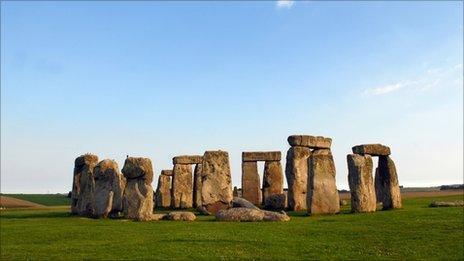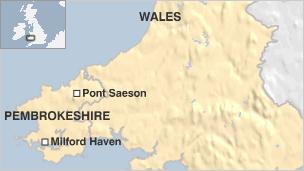Stonehenge rocks Pembrokeshire link confirmed
- Published

Archaeologists hope the find will enable them to discover how the stones were transported to Stonehenge
Experts say they have confirmed for the first time the precise origin of some of the rocks at Stonehenge.
It has long been suspected that rhyolites from the northern Preseli Hills helped build the monument.
But research by National Museum Wales and Leicester University has identified their source to within 70m (230ft) of Craig Rhos-y-felin, near Pont Saeson.
The museum's Dr Richard Bevins said the find would help experts work out how the stones were moved to Wiltshire.
For nine months Dr Bevins, keeper of geology at National Museum Wales, and Dr Rob Ixer of Leicester University collected and identified samples from rock outcrops in Pembrokeshire to try to find the origins of rhyolite debitage rocks that can be found at Stonehenge.
By detailing the mineral content and the textural relationships within the rock, a process known as petrography, they found that 99% of the samples could be matched to rocks found in this particular set of outcrops.
Rhyolitic rocks at Rhos-y-felin, between Ffynnon-groes (Crosswell) and Brynberian, differ from all others in south Wales, they said, which helps locate almost all of Stonehenge's rhyolites to within hundreds of square metres.
Within that area, the rocks differ on a scale of metres or tens of metres, allowing Dr Bevins and Dr Ixer to match some Stonehenge rock samples even more precisely to a point at the extreme north-eastern end of Rhos-y-felin.
Dr Rob Ixer of Leicester University called the discovery of the source of the rocks "quite unexpected and exciting".
'Perseverance'
"Being able to provenance any archaeologically significant rock so precisely is remarkable," he said.
"However, given continued perseverance, we are determined that we shall uncover the origins of most, if not all of the Stonehenge bluestones so allowing archaeologists to continue their speculations well into a third century."
With the location identified, archaeologists will now be able to dig to try and uncover how the stones from Pembrokeshire reached Stonehenge.

The rocks were traced to the Pont Saeson area
"Many have asked the question over the years, how the stones got from Pembrokeshire to Stonehenge," said Dr Bevins. "Was it human transport? Was it due to ice transport?
"Thanks to geological research, we now have a specific source for the rhyolite stones from which to work and an opportunity for archaeologists to answer the question that has been widely debated.
"It is important now that the research continues."
Work is continuing to identify the source of four other stones at Stonehenge which do not come from Rhos-y-felin, he said.
Theory
Experts have long theorised on how the stones were transported from Pembrokeshire to the Stonehenge site when the monument was built from around 3000 BC to 1600 BC.
Perceived wisdom had it that the giant slabs were moved via raft, up the Bristol Channel and River Avon.
But as Pont Saeson is to the north of the Preselis some believe its unlikely that they would have been able to navigate the terrain in order to get the enormous rocks to the coast.
An alternative theory was that nature drove the stone to Stonehenge, in the path of an Ice Age glacier, although the absence of any other Welsh rock in the region seemed to have ruled out the possibility.
In April 2000 a National Lottery Heritage Lottery Fund plan was launched to replicate the 240-mile (386 km) journey of a giant stone from west Wales to Salisbury Plain, by land and sea.
The millennium bluestone project, which tried to use only muscle power and the technology of the ancients, ended in disaster when the stone sank in Milford Haven estuary.
- Published1 September 2011
- Published22 February 2011